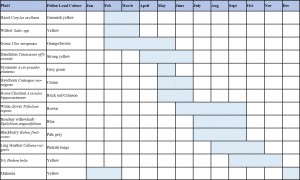Here is a table showing the flowering periods and pollen load colours of some of the more important plants – click it for the bigger picture. Mahonia, snowdrops and hazel are important as early sources of fresh pollen, as is willow. However, in an exceptional spring there could be a honey flow from the willow; something which would never occur with the other three. Especially the latter as it is wind pollinated and as such never bears nectar.
Here are some links to photo’s of pollen loads for the various flowers:
- Clematis spp
- Crocus
- Dandelion (Tarraxacum spp)
- Garden Heathers (Erica spp)
- Gorse (Ulex europaeaus)
- Hawthorn (Crataegus monogyna)
- Hellebore
- Horse Chestnut (Aesculus hippocastanum)
- Ivy (Hedera helix)
- Lime (Tilia spp)
- Melampsora spores
- Raspberry (Rubus idaeus)
- Rosebay willowherb (Chamerion angustifolium)
- Snowdrop (Gallanthus nivalis)
- Sycamore (Acer pseudoplatanus)
- Willows (Salix spp)
Or click these links for more detailed month by month tables:
Click here for Bee Flowers – March
Click here for Bee Flowers – April
Copyright © Beespoke.info, 2014. All Rights Reserved.


Thanks gimlet
Will move some crocus to the sunny side
Mary
Hi gimlet
Love the website
Trying to get the garden in order for the new arrivals.
Have mahonia and snowdrops – no good for stores?
Have they no nectar?
Will crocuses open sufficiently in the shade for the bees.
Regards
Mary
Thanks Mary.
Mahonia and snowdrops are great for bees in the spring – a nice bit of fresh pollen but no stores, if there is nectar it’s only very little and so few bees in the spring…
Crocuses certainly seem to open more in the sunshine and bees are easily chilled in the spring so sunshine is important.
Sycamore and dandelion would be the first flowers you could expect the bees to bring in surplus from and then only if the colonies are good and strong. Rape too is great for both pollen and nectar. Horse chestnut too – look out for dark red pollen.